@rakeshv1108/react-native-map v0.0.4
react-native-maps 
React Native Map components for iOS + Android
Contributing
This project is being maintained by a small group of people, and any help with issues and pull requests are always appreciated. If you are able and willing to contribute, please read the guidelines.
Installation
See Installation Instructions.
See Setup Instructions for the Included Example Project.
Compatibility
React Native Compatibility
Important Notes:
- Fabric is not yet supported:
This feature is currently under development. Fabric is enabled by default in React Native0.76and above, so please disable it for now.
Follow updates on this issue here: react-native-maps/issues/5206.
Kindly refrain from opening duplicate tickets regarding this matter.
Version Requirements:
- Version
1.14.0and above: Requires React Native>= 0.74. - Versions below
1.14.0: Require React Native>= 0.64.3.
Component API
General Usage
import MapView from 'react-native-maps';or
var MapView = require('react-native-maps');This MapView component is built so that features on the map (such as Markers, Polygons, etc.) are specified as children of the MapView itself. This provides an intuitive and react-like API for declaratively controlling features on the map.
Rendering a Map with an initial region
MapView
<MapView
initialRegion={{
latitude: 37.78825,
longitude: -122.4324,
latitudeDelta: 0.0922,
longitudeDelta: 0.0421,
}}
/>Using a MapView while controlling the region as state
getInitialState() {
return {
region: {
latitude: 37.78825,
longitude: -122.4324,
latitudeDelta: 0.0922,
longitudeDelta: 0.0421,
},
};
}
onRegionChange(region) {
this.setState({ region });
}
render() {
return (
<MapView
region={this.state.region}
onRegionChange={this.onRegionChange}
/>
);
}Rendering a list of markers on a map
import {Marker} from 'react-native-maps';
<MapView region={this.state.region} onRegionChange={this.onRegionChange}>
{this.state.markers.map((marker, index) => (
<Marker
key={index}
coordinate={marker.latlng}
title={marker.title}
description={marker.description}
/>
))}
</MapView>;Rendering a Marker with a custom image
- You need to generate an
pngimage with various resolution (lets call themcustom_pin) - for more information go to Android, iOS - put all images in Android drawables and iOS assets dir
- Now you can use the following code:
<Marker
coordinate={{latitude: latitude, longitude: longitude}}
image={{uri: 'custom_pin'}}
/>Note: You can also pass the image binary data like image={require('custom_pin.png')}, but this will not scale good with the different screen sizes.
Rendering a Marker with a custom view
Note: This has performance implications, if you wish for a simpler solution go with a custom image (save your self the headache)
<Marker coordinate={{latitude: latitude, longitude: longitude}}>
<MyCustomMarkerView {...marker} />
</Marker>Rendering a custom Marker with a custom Callout
import {Callout} from 'react-native-maps';
<Marker coordinate={marker.latlng}>
<MyCustomMarkerView {...marker} />
<Callout>
<MyCustomCalloutView {...marker} />
</Callout>
</Marker>;Draggable Markers
<MapView initialRegion={...}>
<Marker draggable
coordinate={this.state.x}
onDragEnd={(e) => this.setState({ x: e.nativeEvent.coordinate })}
/>
</MapView>Using a custom Tile Overlay
Tile Overlay using tile server
import {UrlTile} from 'react-native-maps';
<MapView region={this.state.region} onRegionChange={this.onRegionChange}>
<UrlTile
/**
* The url template of the tile server. The patterns {x} {y} {z} will be replaced at runtime
* For example, http://c.tile.openstreetmap.org/{z}/{x}/{y}.png
*/
urlTemplate={this.state.urlTemplate}
/**
* The maximum zoom level for this tile overlay. Corresponds to the maximumZ setting in
* MKTileOverlay. iOS only.
*/
maximumZ={19}
/**
* flipY allows tiles with inverted y coordinates (origin at bottom left of map)
* to be used. Its default value is false.
*/
flipY={false}
/>
</MapView>;For Android: add the following line in your AndroidManifest.xml
<uses-permission android:name="android.permission.INTERNET" />For IOS: configure App Transport Security in your app
React Native Configuration for Fabric / New Architecture
This library works with Fabric using the New Renderer Interop Layer
There is a warning message that those steps are not necessary; but we couldn't get the example working without them so far.
Configuration Steps
Open your configuration file: Locate the
react-native-configfile in your project directory.Add the following configuration: Include the
unstable_reactLegacyComponentNamesarray for both Android and iOS platforms as shown below:
module.exports = {
project: {
android: {
unstable_reactLegacyComponentNames: [
'AIRMap',
'AIRMapCallout',
'AIRMapCalloutSubview',
'AIRMapCircle',
'AIRMapHeatmap',
'AIRMapLocalTile',
'AIRMapMarker',
'AIRMapOverlay',
'AIRMapPolygon',
'AIRMapPolyline',
'AIRMapUrlTile',
'AIRMapWMSTile',
],
},
ios: {
unstable_reactLegacyComponentNames: [
'AIRMap',
'AIRMapCallout',
'AIRMapCalloutSubview',
'AIRMapCircle',
'AIRMapHeatmap',
'AIRMapLocalTile',
'AIRMapMarker',
'AIRMapOverlay',
'AIRMapPolygon',
'AIRMapPolyline',
'AIRMapUrlTile',
'AIRMapWMSTile',
],
},
},
};checkout the example project to see it in action.
Tile Overlay using local tiles
Tiles can be stored locally within device using xyz tiling scheme and displayed as tile overlay as well. This is usefull especially for offline map usage when tiles are available for selected map region within device storage.
import {LocalTile} from 'react-native-maps';
<MapView region={this.state.region} onRegionChange={this.onRegionChange}>
<LocalTile
/**
* The path template of the locally stored tiles. The patterns {x} {y} {z} will be replaced at runtime
* For example, /storage/emulated/0/mytiles/{z}/{x}/{y}.png
*/
pathTemplate={this.state.pathTemplate}
/**
* The size of provided local tiles (usually 256 or 512).
*/
tileSize={256}
/>
</MapView>;For Android: LocalTile is still just overlay over original map tiles. It means that if device is online, underlying tiles will be still downloaded. If original tiles download/display is not desirable set mapType to 'none'. For example:
<MapView
mapType={Platform.OS == "android" ? "none" : "standard"}
>See OSM Wiki for how to download tiles for offline usage.
Overlaying other components on the map
Place components that you wish to overlay MapView underneath the MapView closing tag. Absolutely position these elements.
render() {
return (
<MapView
region={this.state.region}
/>
<OverlayComponent
style={{position: "absolute", bottom: 50}}
/>
);
}Customizing the map style (Google Maps Only)
The <MapView provider="google" googleMapId="yourStyledMapId" /> Google Maps on iOS and Android supports styling via google cloud platform, the styled maps are published under a googleMapId, by simply setting the property googleMapId to the MapView you can use that styled map
more info here: google map id
MapView Events
The <MapView /> component and its child components have several events that you can subscribe to.
This example displays some of them in a log as a demonstration.
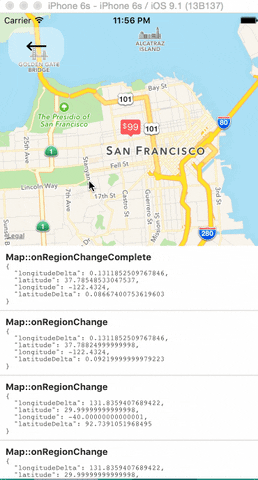

Tracking Region / Location
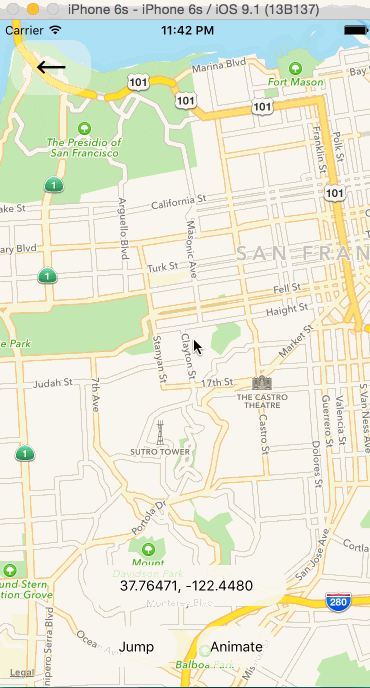
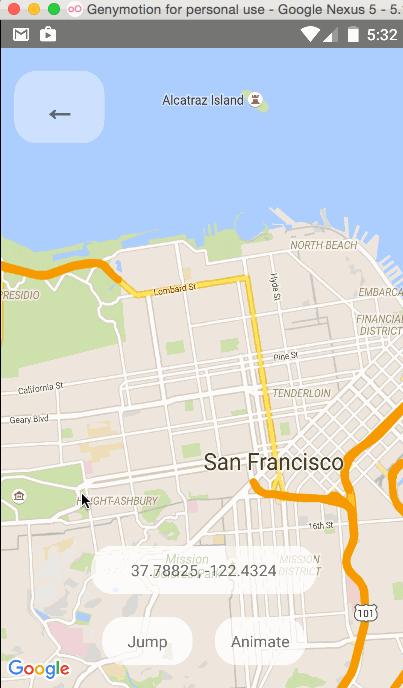
Programmatically Changing Region
One can change the mapview's position using refs and component methods, or by passing in an updated
region prop. The component methods will allow one to animate to a given position like the native
API could.
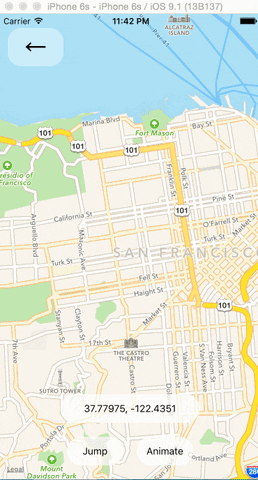
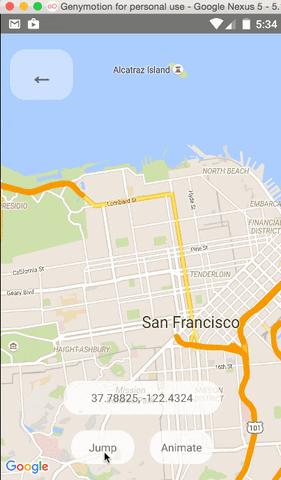
Changing the style of the map

Arbitrary React Views as Markers
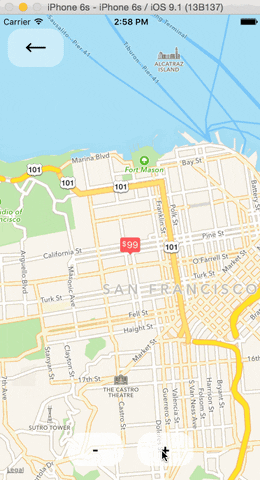
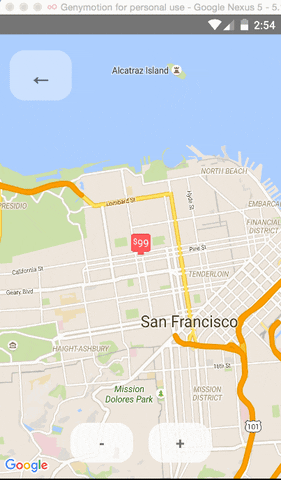
Using the MapView with the Animated API
The <MapView /> component can be made to work with the Animated API, having the entire region prop
be declared as an animated value. This allows one to animate the zoom and position of the MapView along
with other gestures, giving a nice feel.
Further, Marker views can use the animated API to enhance the effect.
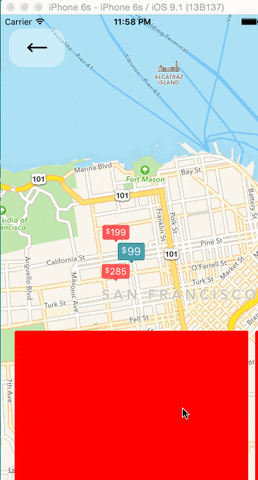
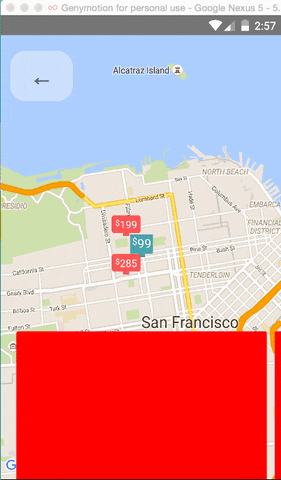
Issue: Since android needs to render its marker views as a bitmap, the animations APIs may not be compatible with the Marker views. Not sure if this can be worked around yet or not.
Markers' coordinates can also be animated, as shown in this example:
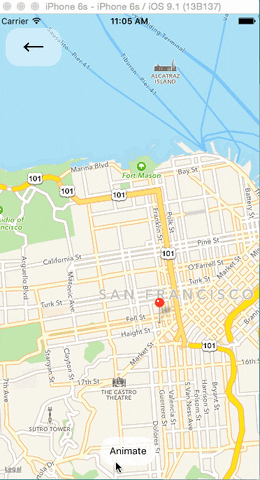

Polygon Creator
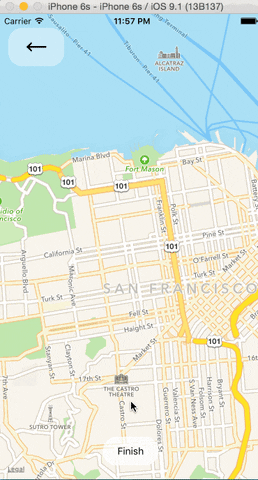

Other Overlays
So far, <Circle />, <Polygon />, and <Polyline /> are available to pass in as children to the
<MapView /> component.

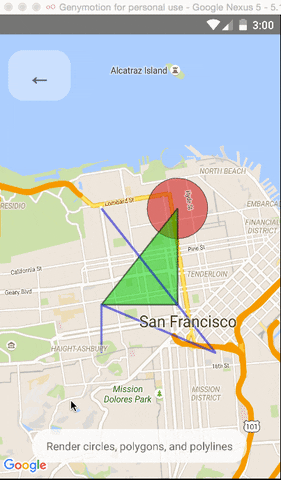
Gradient Polylines (iOS MapKit only)
Gradient polylines can be created using the strokeColors prop of the <Polyline> component.

Default Markers
Default markers will be rendered unless a custom marker is specified. One can optionally adjust the
color of the default marker by using the pinColor prop.
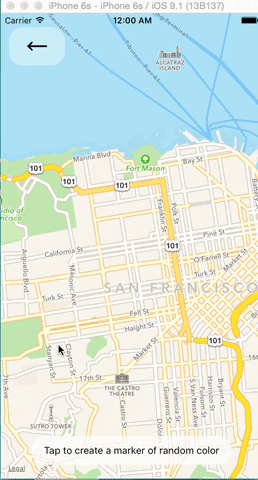

Custom Callouts
Callouts to markers can be completely arbitrary react views, similar to markers. As a result, they can be interacted with like any other view.
Additionally, you can fall back to the standard behavior of just having a title/description through
the <Marker />'s title and description props.
Custom callout views can be the entire tooltip bubble, or just the content inside of the system default bubble.
To handle press on specific subview of callout use <CalloutSubview /> with onPress.
See Callouts.js example.
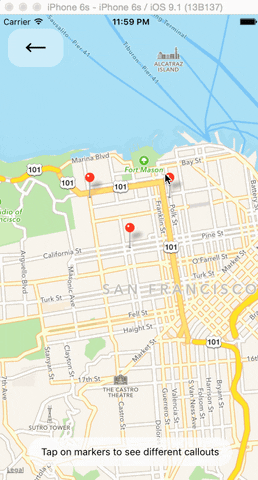
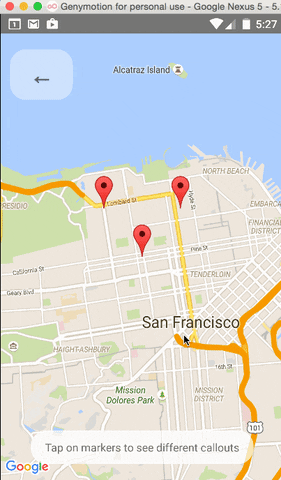
Image-based Markers
Markers can be customized by just using images, and specified using the image prop.

Draggable Markers
Markers are draggable, and emit continuous drag events to update other UI during drags.
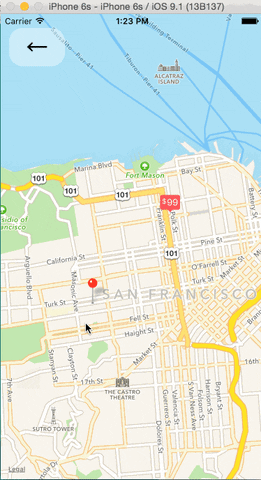
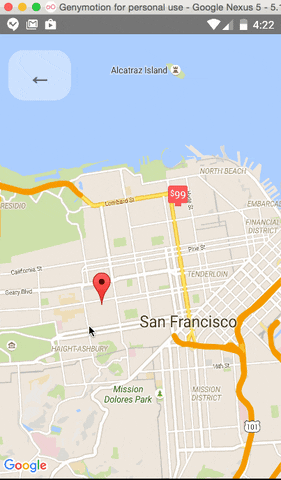
Lite Mode ( Android )
Enable lite mode on Android with liteMode prop. Ideal when having multiple maps in a View or ScrollView.
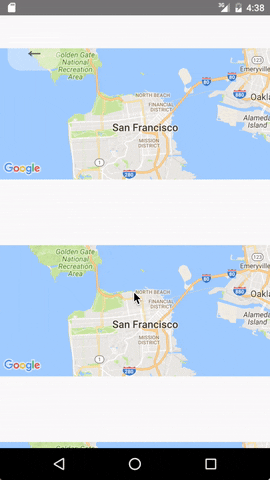
On Poi Click (Google Maps Only)
Poi are clickable, you can catch the event to get its information (usually to get the full detail from Google Place using the placeId).

Animated Region
The MapView can accept an AnimatedRegion value as its region prop. This allows you to utilize the Animated API to control the map's center and zoom.
import MapView, { AnimatedRegion, Animated } from 'react-native-maps';
getInitialState() {
return {
region: new AnimatedRegion({
latitude: LATITUDE,
longitude: LONGITUDE,
latitudeDelta: LATITUDE_DELTA,
longitudeDelta: LONGITUDE_DELTA,
}),
};
}
onRegionChange(region) {
this.state.region.setValue(region);
}
render() {
return (
<Animated
region={this.state.region}
onRegionChange={this.onRegionChange}
/>
);
}Animated Marker Position
Markers can also accept an AnimatedRegion value as a coordinate.
import MapView, { AnimatedRegion, MarkerAnimated } from 'react-native-maps';
getInitialState() {
return {
coordinate: new AnimatedRegion({
latitude: LATITUDE,
longitude: LONGITUDE,
}),
};
}
componentWillReceiveProps(nextProps) {
const duration = 500
if (this.props.coordinate !== nextProps.coordinate) {
if (Platform.OS === 'android') {
if (this.marker) {
this.marker.animateMarkerToCoordinate(
nextProps.coordinate,
duration
);
}
} else {
this.state.coordinate.timing({
...nextProps.coordinate,
useNativeDriver: true, // defaults to false if not passed explicitly
duration
}).start();
}
}
}
render() {
return (
<MapView initialRegion={...}>
<MarkerAnimated
ref={marker => { this.marker = marker }}
coordinate={this.state.coordinate}
/>
</MapView>
);
}Take Snapshot of map
import MapView, { Marker } from 'react-native-maps';
getInitialState() {
return {
coordinate: {
latitude: LATITUDE,
longitude: LONGITUDE,
},
};
}
takeSnapshot () {
// 'takeSnapshot' takes a config object with the
// following options
const snapshot = this.map.takeSnapshot({
width: 300, // optional, when omitted the view-width is used
height: 300, // optional, when omitted the view-height is used
region: {..}, // iOS only, optional region to render
format: 'png', // image formats: 'png', 'jpg' (default: 'png')
quality: 0.8, // image quality: 0..1 (only relevant for jpg, default: 1)
result: 'file' // result types: 'file', 'base64' (default: 'file')
});
snapshot.then((uri) => {
this.setState({ mapSnapshot: uri });
});
}
render() {
return (
<View>
<MapView initialRegion={...} ref={map => { this.map = map }}>
<Marker coordinate={this.state.coordinate} />
</MapView>
<Image source={{ uri: this.state.mapSnapshot.uri }} />
<TouchableOpacity onPress={this.takeSnapshot}>
Take Snapshot
</TouchableOpacity>
</View>
);
}Zoom to Specified Markers
Pass an array of marker identifiers to have the map re-focus.
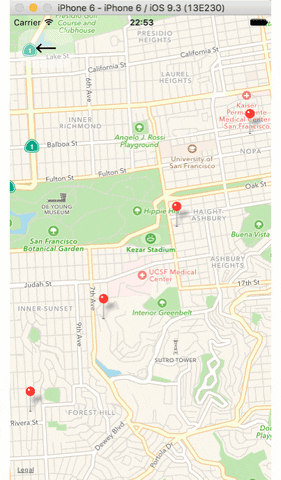
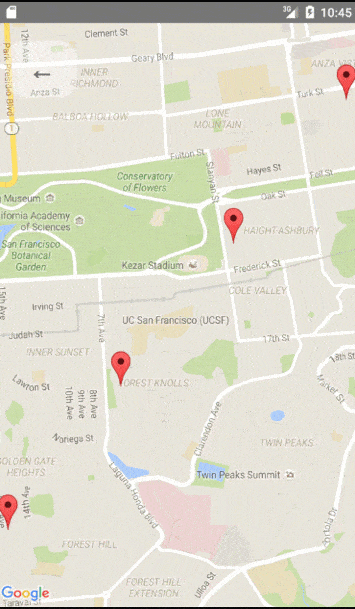
Zoom to Specified Coordinates
Pass an array of coordinates to focus a map region on said coordinates.

Troubleshooting
My map is blank
- Make sure that you have properly installed react-native-maps.
- Check in the logs if there is more informations about the issue.
- Try setting the style of the MapView to an absolute position with top, left, right and bottom values set.
- Make sure you have enabled Google Maps API in Google developer console
const styles = StyleSheet.create({
map: {
...StyleSheet.absoluteFillObject,
},
});<MapView
style={styles.map}
// other props
/>Inputs don't focus
- When inputs don't focus or elements don't respond to tap, look at the order of the view hierarchy, sometimes the issue could be due to ordering of rendered components, prefer putting MapView as the first component.
Bad:
<View>
<TextInput />
<MapView />
</View>Good:
<View>
<MapView />
<TextInput />
</View>Children Components Not Re-Rendering
Components that aren't declared by this library (Ex: Markers, Polyline) must not be children of the MapView component due to MapView's unique rendering methodology. Have your custom components / views outside the MapView component and position absolute to ensure they only re-render as needed. Example: Bad:
<View style={StyleSheet.absoluteFillObject}>
<MapView style={StyleSheet.absoluteFillObject}>
<View style={{position: 'absolute', top: 100, left: 50}} />
</MapView>
</View>Good:
<View style={StyleSheet.absoluteFillObject}>
<MapView style={StyleSheet.absoluteFillObject} />
<View style={{position: 'absolute', top: 100, left: 50}} />
</View>Source: https://github.com/react-native-maps/react-native-maps/issues/1901
Crashing with EXC_BAD_ACCESS on iOS when switching apps
<MapView> using Apple Maps in mapType: "standard" will sometimes crash when you background the app or switch into another app. This is only an issue in XCode using Metal API Validation, and won't happen in production. To eliminate this problem even while debugging in XCode, go to Edit Scheme... -> Run (Debug) -> Diagnostics and uncheck Metal -> API Validation. (h/t @Simon-TechForm).
Source: https://github.com/react-native-maps/react-native-maps/issues/3957#issuecomment-924161121
onRegionChangeComplete() callback is called infinitely
If changing the state in onRegionChangeComplete is called infinitely, add a condition to limit these calls to occur only when the region change was done as a result of a user's action.
onRegionChangeComplete={ (region, gesture) => {
// This fix only works on Google Maps because isGesture is NOT available on Apple Maps
if (!gesture.isGesture) {
return;
}
// You can use
dispatch({ type: "map_region", payload: { mapRegion: region }}); // if using useReducer
// setMapRegionState(region); // if using useState
}}Source: https://github.com/react-native-maps/react-native-maps/issues/846#issuecomment-1210079461
License
Copyright (c) 2017 Airbnb
Licensed under the The MIT License (MIT) (the "License");
you may not use this file except in compliance with the License.
You may obtain a copy of the License at
https://raw.githubusercontent.com/airbnb/react-native-maps/master/LICENSE
Unless required by applicable law or agreed to in writing, software
distributed under the License is distributed on an "AS IS" BASIS,
WITHOUT WARRANTIES OR CONDITIONS OF ANY KIND, either express or implied.
See the License for the specific language governing permissions and
limitations under the License.